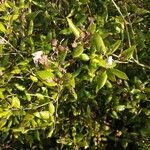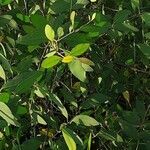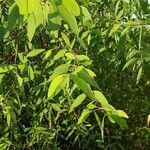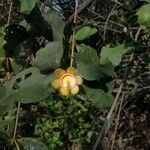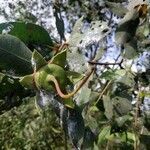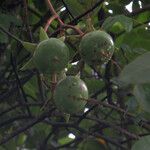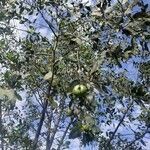Trees, columnar, 5-20 m tall. Pneumatophores ca. 1 m, thin, pointed; ultimate branchlets pendulous, 4-angled. Petiole 2-9 mm; leaf blade elliptic to broadly elliptic or broadly oblong, 4-11 × 2-7 cm, midrib prominent with inconspicuous lateral veins, base rounded, narrowly to broadly attenuate on petiole, apex rounded with minute, thick mucro. Flowers 5-7-merous. Floral tube 2.5-3 cm at anthesis, smooth, flattened in mature fruit; sepals adaxially green, often red-streaked, 1.4-1.9 cm. Petals red, linear, 1.8-2.9 cm × 1-3 mm. Staminal filaments red, sometimes white distally. Fruit [2-]4-5 cm in diam., broader than floral tube. Seeds irregularly angular, ca. 7 mm. Fl. winter, fr. spring-summer. 2n = 22, 24.
Tree 5–20 m high. Leaves: lamina elliptic to broadly elliptic or broadly oblong, 4.5–12 cm long, rounded, mucronate; petiole 2–9 mm long. Inflorescence 1–3-flowered. Flowers 5–7-merous. Sepals elliptic-triangular to ovate-triangular, 1.5–2 cm long, ±erect to spreading, green and warty outside, often red-streaked inside. Hypanthium shallowly cup-shaped, ribbed along sepal margins. Petals linear, 2–3 cm long, 1–3 mm wide, red. Stamens c. 3.5 cm long; filaments red. Ovary superior with 13–20 carpels; style 3–6 cm long. Fruit 2–4 cm diam., wider than hypanthium; hypanthium saucer-shaped. Seeds irregularly angular.
A medium sized tree. It grows 6-20 m tall. The trunk is swollen at the base when young. The trunk can be 30 cm across. Air roots are up to 60 cm long. The smallest branches are jointed and 4 angled. The leaves are thick, leathery and narrow. They are opposite. They are 5-13 cm long by 2-5 cm wide. The flowers occur singly. The petals are red and narrow and fall off very early. The outer case of sepals is green. The fruit are hard, round and pressed down at the tip. They are 4 cm long by 7.5 cm wide. They contain many seeds.
